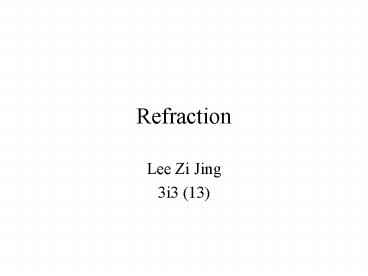Refraction PowerPoint PPT Presentation
1 / 21
Title: Refraction
1
Refraction
- Lee Zi Jing
- 3i3 (13)
2
What is refraction?
- Refraction is the change in direction of a light
wave due to a change in speed. - This usually occurs as light passes through
materials of different refractive index. - This causes a change in speed and hence a
resulting change in direction.
3
Snells law
- Snells law, also know as Snell-Descarte law, is
a formula used to describe the relationship
between the angle of incidence and refraction. - v velocity, SI units are m/s
- n refractive index, which is unitless
4
(No Transcript)
5
Spectacles
- Corrective lenses are used to correct refractive
errors of the eye. - They modifying the effective focal length of the
lens in order to alleviate the effects of
conditions such as nearsightedness (myopia),
farsightedness (hyperemia) or astigmatism.
6
Myopia
- Myopia causes far objects to appear blurred but
near objects are seen clearly. - Myopic eyeglasses have concave lenses, correcting
the refraction error by moving the image of the
distant objects backward onto the retina.
7
Hyperopia
- Hyperopia causes near objects to appeared blurred
but far objects are seen clearly. - Hyperopia glasses have convex lenses.
- They correct the refraction errors by moving the
image of a distant object forward onto the retina.
8
Refracting telescope
- A refracting telescope is a type of optical
telescope that uses a lens as its objective to
form an image. - The refracting telescope design was originally
used in spy glasses and astronomical telescopes
but is also used for long telephoto camera
lenses.
9
Refracting telescope
- The objective in a refracting telescope refracts
or bends light. - This causes parallel light rays to converge at a
focal point. - The telescope converts a bundle of parallel rays
to make an angle a, with the optical axis to a
second parallel bundle with angle ß. - The ratio ß/a is called the angular
magnification. It equals the ratio between the
retinal image sizes obtained with and without the
telescope
10
(No Transcript)
11
Microscope
- A microscope is an instrument used to see objects
too small for the naked eye. - There are many types of microscopes, the most
common and first to be invented is the optical
microscope which uses light to image the sample.
12
Microscope
- The objective lens is a magnifying glass with a
short focal length. - When the sample is brought close to the objective
lens, a magnified, virtual image is obtained. - The ability of a microscope to enlarge the
resolve the image is through varying the focal
length.
13
(No Transcript)
14
Magnifying glass
- A magnifying glass is a convex lens which is used
to produce a magnified image of an object. - It creates a magnified virtual image of an object
behind the lens. - The distance between the lens and the object must
be shorter than the focal length of the lens. - Otherwise, the image appears smaller and inverted.
15
(No Transcript)
16
Camera
- A camera is a device that records/stores images.
These images may be still photographs or moving
images such as videos or movies. - Cameras may work with the light of the visible
spectrum or with other portions of the
electromagnetic spectrum. - It generally consists of an enclosed hollow with
an opening at one end for light to enter, and a
recording or viewing surface for capturing the
light at the other end.
17
Formation of a real image
18
Linear magnification
19
Focusing a camera
20
Camera aperture
21
Changing the aperture

